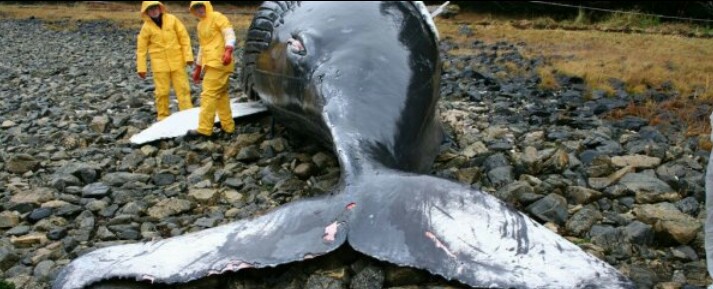
The power behind one of nature's weirdest riddles.
NASA is exploring the power behind one of nature's longest-standing riddles - why fit as a fiddle whales, dolphins, and porpoises seem to lose all ability to know east from west, and wind up stranded on a shoreline some place to die in some horrible, nightmarish way.
We're not discussing a couple of confounded people at times getting lost here - mass strandings can include several creatures for each occasion. Also, specialists now presume that lone something genuinely enormous could be driving them to confer such fatal conduct as once huge mob - our Sun.
"There are a few hypotheses on why these creatures shoreline in vast gatherings, yet not great, strong clarifications," astrophysicist Antti Pulkkinen from NASA's Goddard Space Flight Center told Motherboard.
"One of the potential clarifications that individuals have proposed is that since these creatures utilize attractive fields for route, attractive abnormalities could contribute."
For a considerable length of time, analysts have been endeavoring to clarify the riddle of deadly strandings by indicating current impedances, for example, low-recurrence sonar frameworks utilized by the US Navy that are known to adversely affect whales, dolphins, and walruses.
Yet, while submerged innovations that convey contending sonar signs can bewilder whales, dolphins, and porpoises - referred to by and large as cetaceans - only they can't be what's driving the marvel.
"[H]uman-influenced impacts to don't clarify the majority of the strandings," Pulkkinen says in a press articulation.
Rather, Pulkkinen and his group are taking a gander at something that could affect these creatures - the Sun's capacity to disturb Earth's attractive field, or magnetosphere.
To give you a thought of the degree of these stranding occasions, a great many whales, dolphins, and porpoises shoreline themselves consistently, and we've seen some record-breaking quantities generally.
In 2015, 337 dead whales were found off the bank of Patagonia in southern Chile - the biggest whale stranding of baleen whales to date.
In 2009, 55 false executioner whales discovered themelves stranded on a South African shoreline, and simply a year ago, around 80 whales stranded themselves on the Bay of Bengal drift in India.
They were allegedly so bewildered, of the 36 people that rescuers figured out how to get once again into the ocean, huge numbers of them wound up back on the shoreline.
Past research has indicated the Moon's gravitational impact as possibly disturbing these creatures' capacity to explore the open seas - beach front tempests and outrageous tides around the full and new moon are thought to bewilder them and drive them into hazardously shallow waters.
Be that as it may, nobody's possessed the capacity to convincingly connect these occasions to the kinds of strandings we see, which has driven NASA to look somewhere else for a clarification.
They're presently suggesting that, seeing as cetaceans utilize attractive field detecting to explore, it's a great opportunity to consider the thing that wrecks with Earth's attractive field the most - sun powered tempests.
Sunlight based tempests are caused by enormous blasts of unsafe infinite beams terminated at Earth's magnetosphere from the Sun, which can handicap satellites, cause far reaching power outages, and disturb our GPS-based route.
These very charged particles are so capable, they can without much of a stretch infiltrate the structure of a shuttle, and Earth's attractive shield is our first line of guard against them, however now and then, even it battles.
One especially effective sun based tempest in 2015 seemed to 'air out' Earth's magnetosphere, as a mammoth billow of plasma was shot out from the Sun's external climate, and struck our planet's attractive field at rates of around 2.5 million kilometers for every hour (1.5 million mph).
At the time, analysts were for the most part stressed over our correspondences frameworks, however NASA is presently propelling an examination to check whether such occasions could be behind strange mass strandings that can kill several cetaceans without a moment's delay.
It's initial days, yet the scientists are confident that they'll concoct some authoritative answers - somehow - on account of what number of these strandings they as of now need to research.
"We gauge that records on the request of many cetacean mass strandings will be accessible for think about, along these lines making our investigations factually critical," says Pulkkinen.
"Up until now, there has been next to no quantitative research - only a great deal of hypothesis. What we will do is toss chilly, hard information at this. It's a long-standing puzzle, and it's imperative that we make sense of what's happening."
We can hardly wait to see the outcomes, on the grounds that in the event that it the appropriate response is sun oriented tempests, researchers are now taking a shot at ways that we can gauge them better, so it could give specialists in stranding 'problem areas resembles New Zealand, Australia, and Cape Cod, Massachusetts a superior possibility of distinguishing and reacting to such occasions.
"In the event that we comprehend the connection between the two, we might have the capacity to utilize perceptions of sunlight based tempests as an early cautioning for potential strandings to happen," says one of the group, Katie Moore, from the International Fund for Animal Welfare's worldwide Animal Rescue Program.
"This would permit stranding responders in worldwide hotspots, and truly around the globe, to be better arranged to react, therefore having the chance to spare more creatures."